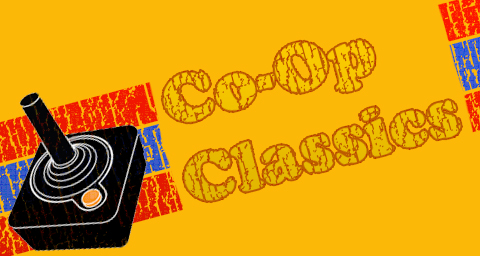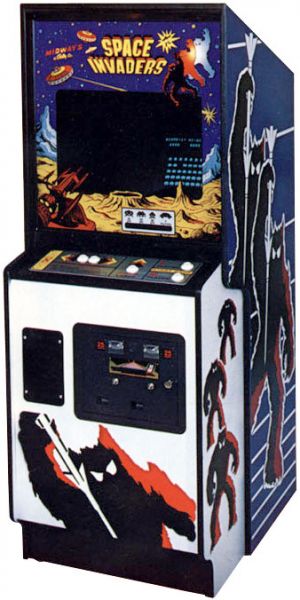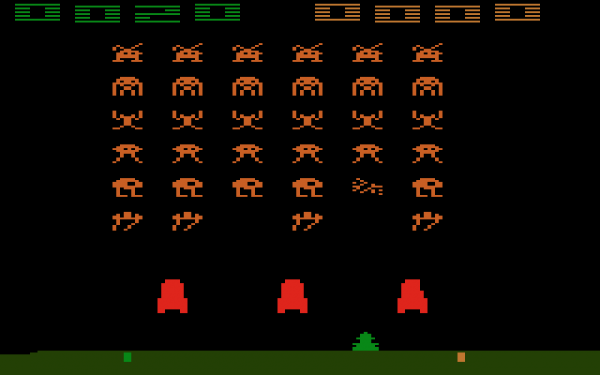

There are not many video games that the average person off the street can name. Pac-Man is probably one of them, likely the most famous game of all time, but a close second would have to be Space Invaders. It is one of the iconic video games of the Golden Age. Considered the first smash hit arcade game, the original alien invaders are still popular across the world. So successful was Space Invaders that it became the first "port", being translated to cartridge form for Atari's VCS, also known as the 2600 console. It was in one of the variations of this version that introduced cooperative elements to the classic gameplay in Space Invaders.
You can't really talk about the Atari 2600 version without discussing the impact the original Space Invaders had. 1978 was the prehistoric age of video gaming. Most games of the time were simple black and white affairs, and many were based on sports, driving, or other realistic activities. Pong and countless variants were everywhere, and racing games like Night Driver were an established genre; you could even emulate driving a Fire Truck with a friend if you wanted. Then, along came Space Invaders, and everything changed. The Golden Age of arcade gaming had officially begun.

What was it that made Space Invaders so popular? Surely the glorious artwork adorning the game cabinet was one thing. Bright and colorful, yet with eerie, menacing characters, the art certainly caught the eye. Looking down onto the screen, one would immediately notice the color graphics. Of course, the game didn't really have color graphics; instead, overlay was added to the top of the screen which allowed you to differentiate between rows of aliens by color. This was incredibly useful, as you really wanted to achieve that coveted high score, which was another inclusion that made Space Invaders stand out from the pack.
One could argue that the success of Star Wars and the resulting science fiction craze boosted Space Invaders' popularity, as well. So great was the demand for Space Invaders in Japan that there was a coin shortage as people dropped 100-yen coins into the addicting game's slots. Over 100,000 cabinets were produced in Japan and another 60,000 in the United States. No other game up to that point in time even came close to those numbers. Much more could be said about the arcade release of Space Invaders, but we must hasten on to the home console version in order to discuss the co-op.

The fledgling home console market had been dominated by dedicated Pong machines of various types through the mid 1970s. In 1977, Atari released the Video Computer System, or VCS, which would later become known as the Atari 2600. With the capability to swap games using a cartridge system, backing in department store catalogs, and a strong slate of game releases, the system became a success. But the 2600 wasn't yet the powerhouse industry leader it would become in the early 80s. Always looking for new ways to innovate, Atari obtained the rights to sell a version of Space Invaders for the 2600. This was the first time such an agreement had been made, making the Atari 2600 Space Invaders cartridge the first officially licensed arcade game conversion.
This would prove to be a masterstroke for Atari. When Space Invaders was released in cartridge form in 1980, sales of the 2600 went through the roof. Many people bought Atari's system just to play Space Invaders, and thus it became one of the earliest known instances of a "killer app". The VCS version of Space Invaders was an excellent rendering, quite authentic in most respects. While the design wasn't absolutely faithful, the gameplay was just as addicting on TV sets at home as it was in the arcades.
One of the challenges of adapting an arcade game to home console use is the fact that arcade titles, by design, are not meant to last long. The entire point was to keep fans plugging in more quarters in order to play longer. For a home console, short playtimes don't quite work, and so, to add value to the purchase, Atari included a staggering amount of variations to the basic Space Invaders theme. In all, 112 such variants were included. That may sound crazy to those of us who are used to a handful of game modes in modern consoles, but it wasn't uncommon at the time. As you might expect, the variations were often minor, but in a few cases, the changes were significant, and this was certainly the case for the cooperative gameplay types.
The first co-op variant was very much what you'd see in far-off sequels like Space Invaders Extreme. Two players controlled ships independently, and played at the same time. Though the manual technically listed this as a competitive mode, the only head-to-head elements were the individual high scores and the fact that players scored points when the other player lost a life. Lives were shared, so the game was over when three ships were lost by either player, or in combination.
The more innovative partnership modes were far more creative, and required a tremendous level of patience and a desire for teamwork in order to fend off the aliens with any degree of success. In one variant, the left player controlled the cannon until he fired a shot, and which point the right player took over, and so on. A second co-op variant had one player moving the cannon, while the other was in charge of firing it. Oddest of all was the variant which had both players controlling one cannon at the same time; the player on the left could move it left only, the partner, just to the right. Either could fire the cannon. I can only imagine the impromptu fights, heated arguments, trash talking, and giddy fits of laughter that would come about as the result of playing these strange yet intensely cooperative variants.
Video games in general owe a tremendous debt of gratitude to Space Invaders, but fans of co-op especially should recognize the tremendous impact it had on gaming. Shoot-em-ups like the Raiden series, Ikaruga, and countless others are the direct descendants of this innovative ancestor. The Atari 2600 port, along with Space Invaders II, were among the first cooperative video game experiences that can be found in video game history, and both are the immediate progeny of the original. Space Invaders is an unarguable classic that has literally shaped the face of cooperative video games as we know them today.